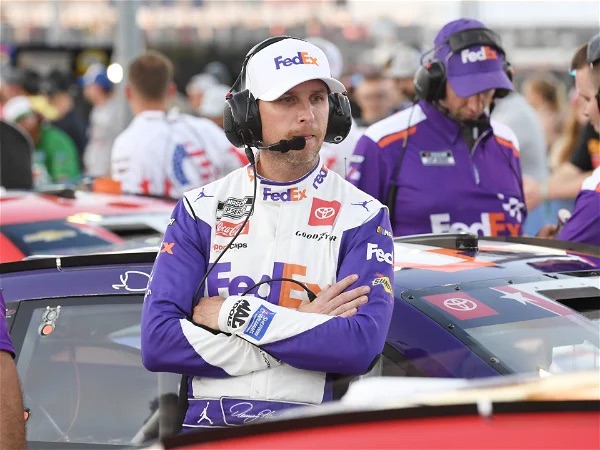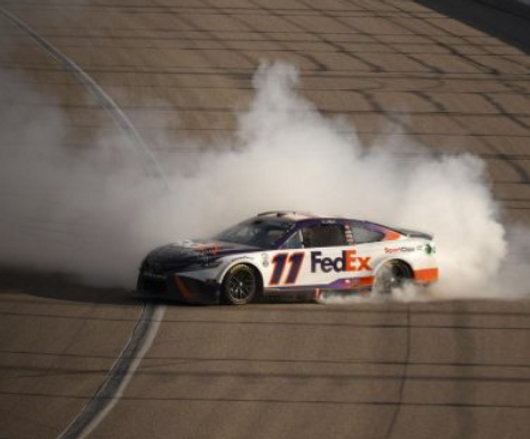
Many discuss it, but few have provided a solution: NASCAR’s intricate dance with fuel mileage racing. This concept isn’t new; conserving fuel is one of the essential skills for a race car driver. This was evident with the debut of the NextGen car at the Brickyard 400’s celebrated return. Recently, this ‘half-throttle’ style of racing has faced criticism for slowing down races and prolonging finishes. The 2024 Brickyard 400 on the Indianapolis Motor Speedway’s 2.5-mile oval was no exception. On a track of that size, teams inevitably confronted their fuel efficiency challenges. From Stage 2 winner Bubba Wallace to near-champion Brad Keselowski, no one was safe on that Sunday. Despite Kyle Larson’s victory, his Joe Gibbs rival, Denny Hamlin, criticized NASCAR’s inherent fuel efficiency issues on his podcast, Actions Detrimental.
Denny Hamlin details fuel economy conundrum days after Indy DNF
There are multiple strategies to save fuel during a NASCAR race. Drivers might lift in the turns to conserve fuel, maintain a draft on long tracks at lower RPM, or turn off engines during caution laps, as Joey Logano did to secure a win at Nashville. However, beyond preparation, fuel mileage often boils down to luck. For instance, Brad Keselowski couldn’t have predicted the second overtime attempt at the Brickyard 400’s finish, brought about by the race’s ninth caution. As a result, Keselowski had to relinquish his lead to Kyle Larson after running out of fuel, set to expire after the originally planned 160 laps. Ryan Preece also faced this fate, running out of fuel and spinning to cause the final caution shortly after the white flag dropped on Lap 167.
On his podcast, Denny Hamlin discussed the Brickyard’s overtime fuel issues, saying, “You’re one caution away from this thing going just as planned, and then we got one caution. But then the second one was like, now that puts us in a weird fuel window where we’re short. So we’re going to have to save.” He highlighted what some might see as an unfair advantage: “But others that were in the back of the pack like the #5 because he had his issue with 90 to go or something like that. He had fuel. So he then just kind of topped off and then it just, it f* everything up. It really did. And so we spent the whole last run having to save. And so it’s frustrating because it was very similar to like the superspeedway races that we have had all year.” Hamlin expressed his frustration with his inability to race full-throttle, noting, “If the race is 160 laps… I think I ran hard 25 of those laps. So it’s just I’m so tired of running fuel mileage races where we’re all running half-throttle.”
“I wish we could do something about it,” lamented Hamlin. “But it’s like, I don’t know if it helps you sometimes, it hurts you sometimes. But I just think for the racing’s sake man, do we really want NBC to have to sit here and explain all these different things and fuel and all? It’s like don’t you just want to see us out there racing…? Well, he’s doing a great job explaining what’s happening, but can we stop that from happening somehow where it’s like fuel mileage races?” Indeed, many fans find it overstimulating to process so much real-time digital information during a NASCAR race. The real question is whether this sensory overload detracts from the thrill of the race, beyond just the NextGen car’s fuel inefficiency. Hamlin shed light on another major issue affecting modern NASCAR racing.
After his Lap 159 DNF at Indy, Hamlin pointed out the Gen 7 car’s inability to pass or perform optimally on superspeedways and larger tracks. “You couldn’t pass. You’re all just running in a line there saving fuel, like a speedway race. We were just doing everything to get to the finish and didn’t make it,” he said. His words resonate, considering that races at Talladega and Daytona also turned into fuel-mileage races with minimal lead changes, sparking fan outrage. Ironically, Kyle Busch lost crucial track position after his #8 RCR Chevy collided with Hamlin’s #11 Toyota while attempting a top-5 pass, causing the race to go into overtime. Meanwhile, race-winner Kyle Larson, who was outside the top 20 with 30 laps to go, strategically and luckily passed 17 cars to reach Keselowski’s bumper before the final restart. This disparity raises questions. Just three years into the NextGen experiment, some argue that stage racing has hurt NASCAR’s weekly product, while others believe introducing permanent pit windows could improve the sport. However, the root of the problem is not so simple.
As the outcry over these issues grows, NASCAR must seek permanent changes to win back fans disheartened by the controversy surrounding the Brickyard 400’s return. What changes do you think NASCAR should implement to address these concerns?


